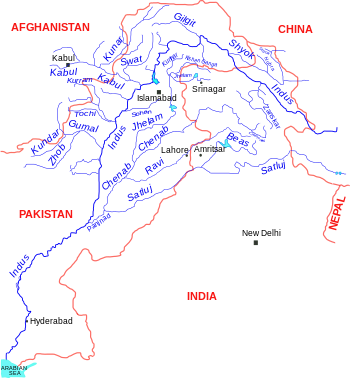సింధునదీ జలాల ఒప్పందం
సింధు నదీజలాల ఒప్పందం అన్నది ప్రపంచ బ్యాంకు (అప్పట్లో అంతర్జాతీయ అభివృద్ధి, పునర్నిర్మాణ బ్యాంకు) మధ్యవర్తిత్వంతో భారతదేశం, పాకిస్తాన్ ల నడుమ ఏర్పడ్డ నీటి పంపిణీ ఒప్పందం.[1] ఈ ఒప్పందంపై 1960 సెప్టెంబరు 19న అప్పటి భారత ప్రధాని జవహర్ లాల్ నెహ్రూ, పాకిస్తాన్ అధ్యక్షుడు ఆయుబ్ ఖాన్ లు సంతకం చేశారు. ఈ ఒప్పందం ప్రకారం తూర్పు నదులు మూడు - బియాస్, రావి, సట్లెజ్ లపై భారతదేశానికి, మూడు పశ్చిమ నదులు - సింధు, చీనాబ్, ఝీలంలపై పాకిస్తాన్కూ నియంత్రణ ఉంటుంది. జలాలు ఎలా పంచుకోవాలన్న విషయం ఈ సందర్భంలో మరింత వివాదాస్పదం. పాకిస్తాన్ నదులు భారతదేశంలో మొదట ప్రవహిస్తూండడంతో ఒప్పందం భారతదేశాన్ని నీటిని సాగు, రవాణా, విద్యుత్ ఉత్పత్తి అవసరాలకు వినియోగించుకోమంటూనే నదులపై భారతీయ నిర్మాణాలు చేయదగ్గవి, చేయరానివేమిటో నిర్ధారించింది. సింధునదీ పరీవాహక ప్రాంతపు నదుల జన్మస్థానం భారతదేశం కావడంతో భారతదేశం పాకిస్తాన్లో కరువు, కాటకాలు సృష్టించగలదనీ, ప్రత్యేకించి యుద్ధ సమయంలో చేస్తుందనీ పాకిస్తాన్కు ఉన్న భయాల వల్ల ఈ ఒప్పందం ఏర్పడింది.[2] 1960లో ఒప్పందం అమలులోకి వచ్చిన నాటి నుంచి, భారతదేశం, పాకిస్తాన్లు జలాల గురించి యుద్ధంలోకి వెళ్ళలేదు. అనేక విభేదాలు, వివాదాలు ఒప్పందం పరిధిలోని న్యాయపరమైన పద్ధతుల్లోనే పరిష్కరించుకున్నారు. నిపుణులు కొన్ని సాంకేతిక నిర్దేశాలను నవీకరించి, వాతావరణ మార్పులకు అనుగుణంగా ఒప్పందపు పరిధిని విస్తరించాలనడం ఎలావున్నా, ప్రస్తుతం ప్రపంచంలోనే ఈ ఒప్పందం అత్యంత విజయవంతమైన నీటి పంపకం ఒప్పందంగా పేరొందింది.[3] ఒప్పందపు నిబంధనలకు అనుగుణంగా భారతదేశం మొత్తం సింధు నదీ జలాల్లో 20% మాత్రమే ఉపయోగించుకోగలుగుతుంది.[4][5][6]

నిబంధనలు
మార్చుసింధు నదీ వ్యవస్థలో మూడు పశ్చిమ నదులు - సింధు, ఝీలం, చీనాబ్, మూడు తూర్పు నదులు సట్లెజ్, బియాస్, రావి ఉన్నాయి. ఒప్పందంలోని 5.1 ఆర్టికల్, సింధు నదిలో తూర్పు ఒడ్డు నుంచి కలిసిపోయే రావి, బియాస్, సట్లెజ్, ఝీలం, చీనాబ్ ల పంపిణీ The treaty, under Article 5.1, envisages the sharing of waters of the rivers Ravi, Beas, Sutlej, Jhelum and Chenab which join the Indus River on its left bank (eastern side) in Pakistan. According to this treaty, Ravi, Beas and Sutlej, which constitute the eastern rivers, are allocated for exclusive use by India before they enter Pakistan. However, a transition period of 10 years was permitted in which India was bound to supply water to Pakistan from these rivers until Pakistan was able to build the canal system for utilization of waters of Jhelum, Chenab and the Indus itself, allocated to it under the treaty. Similarly, Pakistan has exclusive use of the western rivers Jhelum, Chenab and Indus. Pakistan also received one-time financial compensation for the loss of water from the eastern rivers. Since March 31, 1970, after the 10-year moratorium, India has secured full rights for use of the waters of the three rivers allocated to it.[7][8] The treaty resulted in partitioning of the rivers rather than sharing of their waters.[9]
మూలాలు
మార్చు- ↑ "Text of 'Indus Water Treaty', Ministry of water resources, Govt. of India" Archived 2014-06-05 at the Wayback Machine.
- ↑ War over water The Guardian, Monday 3 June 2002 01.06 BST
- ↑ Strategic Foresight Group, The Indus Equation Report
- ↑ C.A. Brebbia (4 September 2013).
- ↑ Map Workbook[permanent dead link].
- ↑ Biswaroop Roy Chowdhury.
- ↑ Garg, Santosh Kumar (1999).
- ↑ "Indus Waters Treaty 1960" (pdf).
- ↑ "Water Sharing Conflicts Between Countries, and Approaches to Resolving Them" (PDF).